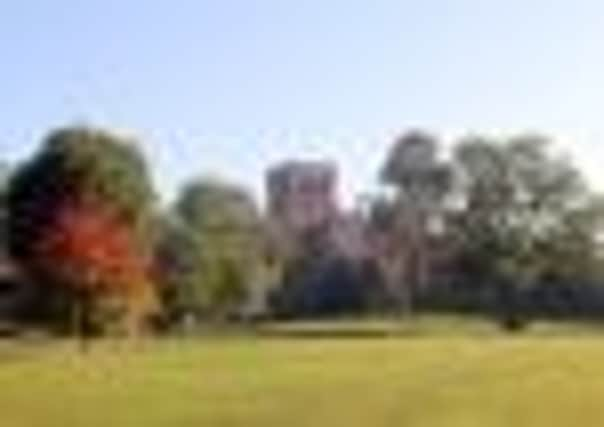The path to Rome


You will not want for places to stop for refreshment in St Albans. There are probably more pubs, restaurants and cafés in the city than in any other comparable space. And, with all credit to the landlords, most are colourfully bedecked with floral arrangements. Not just one or two hanging baskets or window boxes, but dozens of them.
While home to thousands of commuters who pack the trains into London each morning, for curious tourists, St Albans is also steeped in custom and history.
Advertisement
Hide AdAdvertisement
Hide AdTake the Verulanium (the Roman name for St Albans) Museum, just down the hill from the cathedral. The museum is fairly new, shaped very much like a bath house, and it contains some eye-boggling artefacts, huge stretches of mosaic recovered from ancient villas, the tools that tradesmen used, their pots, and much sculpture. But there, in a little case, is also a lead coffin, which once contained a child’s body. It is slightly dented, and around it are displayed some of the gifts the grieving parents sent with their son or daughter into the next world. That is poignant enough, but there too are the child’s teeth, stained bright green from the copper coin the toddler held in its mouth (money to pay the ferryman Charon for passage across the River Styx to an afterlife). Dated around 220AD, that coin, those teeth, are a reminder that all life is transitory, and its simplicity contrasts with the inflated and self-righteous pomposity of the inscriptions on some of the tombstones that surround the medieval cathedral vandalised by misguided Victorians.
St Albans other museum concentrates more on the Saxon and medieval development of the town, and takes you through recent history until the present day, but that’s back up in the main town, and while you are down in the Roman area, have a stroll around St Michael’s Church, parts of which date back to the 10th-century, and which stands on the site of the basilica.
It is more than likely that Alban (from whom the city gets its modern name) was tried and executed here. He is the first Christian martyr, beheaded in 324AD on the orders of the Emperor Diocletian, who did not share the young man’s faith.
Verulanium (or Verulam) was as large and important to the Romans as Colchester, but when they left, it didn’t take long for the good people of the Dark Ages to cannibalise what they had left behind – bricks from the ruined Roman city were re-used in many buildings, and both the cathedral and St Michael’s owe a lot to this early form of recycling.
Advertisement
Hide AdAdvertisement
Hide AdThe smaller building has a very fine monument to Sir Francis Bacon, the politician, scientist and writer, and Keeper of the Great Seal for that wily and capricious monarch, James I.
Along the lane from St Michael’s and just over the busy A4147, is one of the most complete Roman amphitheatres in northern Europe – or at least, the foundations of it. Now it is on private land, but you are allowed to wander at will past the rooms where the actors changed, and on the banks where the spectators sat. It is big. Very big.
A trip to St Albans would not be complete without a visit to the Cathedral and Abbey Church of Saint Alban which, amazingly, offers free entrance. It’s one of my all time favourite buildings. Well, most of it. Sadly, a zealous Victorian called Edmund Beckett, the first Lord Grimthorpe, who was described as a “pompous, righteous bully” got his clammy hands on it. Grimthorpe imposed his own “vision” of ghastly gothic on a building that, in part, dates back to 11 years after the Norman conquest. We can raise a prayer of thanks now that he didn’t do more harm than he did.
He did not, thank heavens, manage to get his hands on the wonderful medieval paintings of the nave, which are a national treasure. Or the mind-boggling nave screen in the Lady Chapel, St Alban’s shrine or the tomb of Humphrey, Duke of Gloucester, the brother to Henry V. The most beautiful sections of this amazing building are the arches of the early church which are built with bricks from the Roman ruins and flint, and you will be standing in one of the longest naves in Europe.
Advertisement
Hide AdAdvertisement
Hide AdOutside there is St Albans School, a rather posh minor public institution that boasts (among other things) that it is the only school in the English speaking world to have educated a Pope – Adrian IV. And just up the lane is the Old Town Hall, a rather fine Georgian-style building, in which you’ll find the Tourist Information offices.
There’s much more for a long weekend – among the attractions are the Redbourn Village Museum, the De Havilland Aircraft Heritage Centre and the St Albans Organ Theatre, which features a rare collection of musical instruments. But if you are seeing the sights, do remember to wear sensible walking shoes.
Getting there
East Coast run regular services from Leeds and Doncaster to Stevenage and from there connect with the 300 First National bus service to St Albans. There are speedy services from St Pancras International if you are in London and wish to explore further afield. More details on accommodation and places to visit from The Tourist Information Centre on 01727 864511, or by email at [email protected]